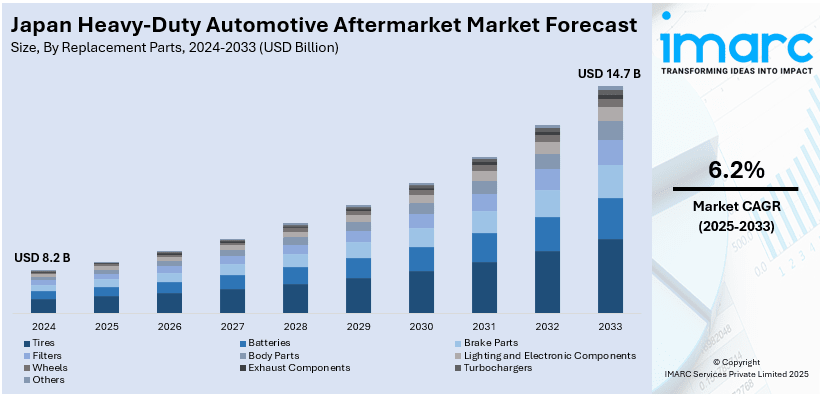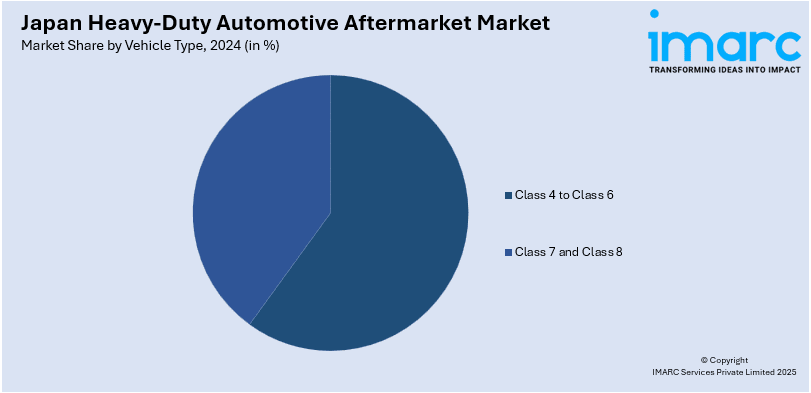
Japan Heavy-Duty Automotive Aftermarket Market Size, Share, Trends and Forecast by Replacement Part, Vehicle Type, Service Channel, and Region, 2025-2033
Japan Heavy-Duty Automotive Aftermarket Market Overview:
The Japan heavy-duty automotive aftermarket market size reached USD 8.2 Billion in 2024. Looking forward, IMARC Group expects the market to reach USD 14.7 Billion by 2033, exhibiting a growth rate (CAGR) of 6.2% during 2025-2033. The market is driven by an aging commercial vehicle fleet, rising e-commerce logistics demand, digitalization of maintenance services, stringent emission regulations, and increased focus on fleet uptime. Growth is also supported by innovations in telematics, remanufacturing adoption, and a shift toward predictive maintenance to reduce operational downtime.
|
Report Attribute
|
Key Statistics
|
|---|---|
|
Base Year
|
2024 |
|
Forecast Years
|
2025-2033
|
|
Historical Years
|
2019-2024
|
| Market Size in 2024 | USD 8.2 Billion |
| Market Forecast in 2033 | USD 14.7 Billion |
| Market Growth Rate 2025-2033 | 6.2% |
Japan Heavy-Duty Automotive Aftermarket Market Trends:
Expansion of Predictive Maintenance and Telematics Integration
Japanese heavy-duty fleet operators are increasingly incorporating predictive maintenance solutions powered by telematics and IoT. These systems help monitor vehicle health in real time, reducing unplanned repairs and optimizing parts replacement cycles. With Japan’s high standards for operational reliability, predictive maintenance tools are gaining acceptance among logistics firms, bus fleets, and public transport services. Sensor-enabled systems that detect early signs of wear allow service providers to anticipate part failures and schedule repairs during non-peak hours, minimizing disruptions. Moreover, government-supported digital transformation in transportation has facilitated the deployment of these tools. This shift not only improves cost-efficiency but also supports compliance with safety and emission norms, aligning with Japan’s broader policy goals for smart infrastructure and mobility. For instance, the Japanese Ministry of Land, Infrastructure, Transport and Tourism (MLIT) approved legislation to regulate Level 3 autonomous driving technology. Vehicles using this system are capable of detecting their surroundings and making informed decisions based on the data they gather.

Rise of E-commerce-Driven Logistics Support Services
Japan’s e-commerce sector continues to expand, fueling demand for reliable heavy-duty freight and last-mile delivery solutions. For instance, as per industry reports, the e-commerce logistics market in Japan is estimated at USD 22.42 Billion in 2024 and is expected to reach USD 27.91 Billion by 2029, growing at a CAGR of 4.95% during the forecast period. As a result, aftermarket service providers are scaling up parts availability, maintenance networks, and roadside assistance tailored to logistics carriers. This trend has spurred partnerships between parts distributors, fleet operators, and digital platforms offering inventory visibility, automated procurement, and same-day delivery of critical components. Companies are also investing in mobile service units to provide on-site repairs, minimizing downtime for delivery fleets. Given Japan’s dense urban regions and tightly scheduled distribution cycles, such support systems are becoming integral. This shift toward speed and efficiency in aftermarket logistics has created new growth opportunities across urban freight, third-party logistics, and regional supply chain services.
Japan Heavy-Duty Automotive Aftermarket Market Segmentation:
IMARC Group provides an analysis of the key trends in each segment of the market, along with forecasts at the country and regional levels for 2025-2033. Our report has categorized the market based on replacement part, vehicle type, and service channel.
Replacement Part Insights:
- Tires
- Battery
- Brake Parts
- Filters
- Body Parts
- Lighting and Electronic Components
- Wheels
- Exhaust Components
- Turbochargers
- Others
The report has provided a detailed breakup and analysis of the market based on the replacement part. This includes tires, battery, brake parts, filters, body parts, lighting and electronic components, wheels, exhaust components, turbochargers, and others.
Vehicle Type Insights:

- Class 4 to Class 6
- Class 7 and Class 8
A detailed breakup and analysis of the market based on the vehicle type have also been provided in the report. This includes class 4 to class 6 and class 7 and class 8.
Service Channel Insights:
- DIY
- OE Seller
- DIFM
A detailed breakup and analysis of the market based on the service channel have also been provided in the report. This includes DIY, OE seller, and DIFM.
Regional Insights:
- Kanto Region
- Kansai/Kinki Region
- Central/ Chubu Region
- Kyushu-Okinawa Region
- Tohoku Region
- Chugoku Region
- Hokkaido Region
- Shikoku Region
The report has also provided a comprehensive analysis of all the major regional markets, which include Kanto, Kansai/Kinki, Central/ Chubu, Kyushu-Okinawa, Tohoku, Chugoku, Hokkaido, and Shikoku region.
Competitive Landscape:
The market research report has also provided a comprehensive analysis of the competitive landscape. Competitive analysis such as market structure, key player positioning, top winning strategies, competitive dashboard, and company evaluation quadrant has been covered in the report. Also, detailed profiles of all major companies have been provided.
Japan Heavy-Duty Automotive Aftermarket Market News:
- In December 2024, HKS Co., Ltd. and Nippon Seiki Co., Ltd. (under its Defi brand) announced a strategic collaboration to launch advanced electronic meter systems and precision instruments for EVs. Combining HKS’ tuning and control system expertise with Defi’s trusted vehicle instrumentation technology, the new products will debut at the Tokyo Auto Salon 2025. This partnership unites two leading Japanese aftermarket firms to create high-performance solutions that target global markets, bringing innovation to EV instrumentation and setting new standards in automotive aftermarket technology.
- In December 2024, Hitachi Astemo Aftermarket Germany GmbH, the regional subsidiary of Hitachi Astemo, Ltd., partnered with Gulf Worldwide Distribution (GWD) to expand the availability of its TOKICO brand shock absorbers globally. GWD will serve as an official distributor and stockist. This strategic move will improve regional access to Hitachi Astemo’s high-quality aftermarket parts and strengthen its presence in key markets.
Japan Heavy-Duty Automotive Aftermarket Market Report Coverage:
| Report Features | Details |
|---|---|
| Base Year of the Analysis | 2024 |
| Historical Period | 2019-2024 |
| Forecast Period | 2025-2033 |
| Units | Billion USD |
| Scope of the Report |
Exploration of Historical Trends and Market Outlook, Industry Catalysts and Challenges, Segment-Wise Historical and Future Market Assessment:
|
| Replacement Parts Covered | Tires, Battery, Brake Parts, Filters, Body Parts, Lighting and Electronic Components, Wheels, Exhaust Components, Turbochargers, Others |
| Vehicle Types Covered | Class 4 to Class 6, Class 7 and Class 8 |
| Service Channels Covered | DIY, OE Seller, DIFM |
| Regions Covered | Kanto Region, Kansai/Kinki Region, Central/Chubu Region, Kyushu-Okinawa Region, Tohoku Region, Chugoku Region, Hokkaido Region, Shikoku Region |
| Customization Scope | 10% Free Customization |
| Post-Sale Analyst Support | 10-12 Weeks |
| Delivery Format | PDF and Excel through Email (We can also provide the editable version of the report in PPT/Word format on special request) |
Key Questions Answered in This Report:
- How has the Japan heavy-duty automotive aftermarket market performed so far and how will it perform in the coming years?
- What is the breakup of the Japan heavy-duty automotive aftermarket market on the basis of replacement part?
- What is the breakup of the Japan heavy-duty automotive aftermarket market on the basis of vehicle type?
- What is the breakup of the Japan heavy-duty automotive aftermarket market on the basis of sales channel?
- What are the various stages in the value chain of the Japan heavy-duty automotive aftermarket market?
- What are the key driving factors and challenges in the Japan heavy-duty automotive aftermarket market?
- What is the structure of the Japan heavy-duty automotive aftermarket market and who are the key players?
- What is the degree of competition in the Japan heavy-duty automotive aftermarket market?
Key Benefits for Stakeholders:
- IMARC’s industry report offers a comprehensive quantitative analysis of various market segments, historical and current market trends, market forecasts, and dynamics of the Japan heavy-duty automotive aftermarket market from 2019-2033.
- The research report provides the latest information on the market drivers, challenges, and opportunities in the Japan heavy-duty automotive aftermarket market.
- Porter's five forces analysis assist stakeholders in assessing the impact of new entrants, competitive rivalry, supplier power, buyer power, and the threat of substitution. It helps stakeholders to analyze the level of competition within the Japan heavy-duty automotive aftermarket industry and its attractiveness.
- Competitive landscape allows stakeholders to understand their competitive environment and provides an insight into the current positions of key players in the market.
Need more help?
- Speak to our experienced analysts for insights on the current market scenarios.
- Include additional segments and countries to customize the report as per your requirement.
- Gain an unparalleled competitive advantage in your domain by understanding how to utilize the report and positively impacting your operations and revenue.
- For further assistance, please connect with our analysts.
 Request Customization
Request Customization
 Speak to an Analyst
Speak to an Analyst
 Request Brochure
Request Brochure
 Inquire Before Buying
Inquire Before Buying




.webp)




.webp)












